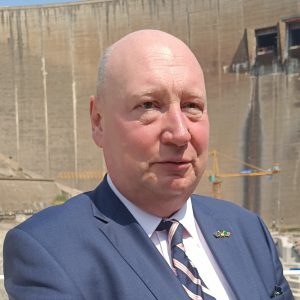
In this edition:
- EU, co-financing partners pour US$300m into the project
- Works enhanced Kariba Dam’s structural integrity
By Conrad Mwanawashe
Recently in Siavonga, Zambia
THE Kariba Dam structural integrity has been enhanced and its lifespan extended by a further half a century thanks to a US$300million lifeline from co-financing partners that have averted potential devastating impact on over three million people downstream, in the event of the dam’s collapse.
The financial assistance was co-financed in parallel by the World Bank (WB) (US$75 million), African Development Bank (AfDB) (US$75 million), SIDA (US$25 million), Zambezi River Authority (ZRA) (US$19.2 million) and the European Union (EU) (EUR113.5 million).
Over the years, the force of the falling water from the sluice gates has eroded the natural rock floor, creating a plunge pool downstream of the dam which is approximately 80 meters deep.
In order to control its future development and avoid dam toe weakening, the best solution consists in enlarging the plunge pool, mainly towards downstream but also towards both banks and protecting the fault in the downstream toe of the dam with a concrete lining.
The reshaping shall facilitate the evacuation of spillage flows in the downstream direction, and avoid the concentration of turbulence in a restricted and confined area, thereby slowing the erosion. These are the first works of its kind in the world.
These works have enhanced the dam’s structural integrity, according to COM Chairperson and Zimbabwe’s Minister of Energy and Power Development, Edgar Moyo.
Minister Moyo was addressing a ceremony to mark the successful completion of the world-first feat of plunge pool reshaping and the commencement of its refilling.

“We were faced with an imminent risk of losing over 500,000 lives if the Kariba Dam collapsed with devastating impacts on over three million people downstream.
“The multiplier effect of this catastrophe would result in the loss of key infrastructure, as well as the agriculture and tourism sectors in Zambia, Zimbabwe and Mozambique,” said Minister Moyo adding that a loss of such an infrastructure would pose a threat to regional energy security.
European Union’s Global Gateway
In terms of the project governance, the contracting authority is the National Authorising Office of the European Development Fund in the Ministry of Finance of the Republic of Zambia, and ZRA is the designated as supervisor to the project, while the source of the funding coming through the European Development Fund.
The EU response was released under a new growth and partnership model, Global Gateway Strategy, European Union’s offer to partner countries to accelerate their twin green and digital transition and narrow the global investment gap.
It boosts sustainable, smart, and secure links in the digital, transport, energy, and climate-relevant sectors.
Global Gateway, through Team Europe – the EU institutions, EU Member States and their financing institutions and private sector – aims to mobilise up to EUR 150 billion for investments to support large-scale projects in Africa.
Under the EU funded component of the programme (plunge pool reshaping) a major milestone was achieved in June 2022 with the competition of the Cofferdam. Dewatering process and excavation works started in the following months.
 “As part of the Global Gateway strategy, we are convinced that access to affordable, reliable, and sustainable energy is a prerequisite and an enabler for Zambia’s and Zimbabwe’s sustainable economic and social development,” according to Henrik Hololei, speaking on behalf of the Zimbabwean and Zambian EU Delegations.
“As part of the Global Gateway strategy, we are convinced that access to affordable, reliable, and sustainable energy is a prerequisite and an enabler for Zambia’s and Zimbabwe’s sustainable economic and social development,” according to Henrik Hololei, speaking on behalf of the Zimbabwean and Zambian EU Delegations.
“The Kariba Dam, its monitoring system, the cofferdam, and the plunge pool excavation represent European engineering at its best. The excavation works were completed in 16 months, which included blasting and hauling a volume of solid rock that could fill more than 120 Olympic swimming pools!,” said Hololei.
President of the European Commission, Ursula von der Leyen, has said: “We will support smart investments in quality infrastructure, respecting the highest social and environmental standards, in line with the EU’s values and standards. The Global Gateway strategy is a template for how Europe can build more resilient connections with the world.”
ZRA COM Co-Chairperson and Zambia’s Minister of Energy, Makozo Chikote, on behalf of the Minister of Finance and National Planning, extended profound gratitude to the European Union for financially supporting the plunge pool works.
“We remain convinced that the decision to allocate the funds towards this project was prudent. As we look forward to improved inflows in the coming seasons, it gives us comfort that one component of the KDRP, with its objective to improve the structural integrity of the Kariba Dam, is over 99% complete. This means that once we complete the spillway refurbishment, we will have no doubt that ZRA will safely operate the dam infrastructure as required,” said Chikote.
Why is the Kariba Dam important?
Considering the climate change impacts worldwide, and the severe drought affecting the region and in particular Zambia and Zimbabwe, it has become essential to diversify the energy mix with different types of renewables and have contingency supply to become more resilient to climate shocks.
Kariba Dam is a concrete arch dam (128 m tall, crest length of 617 m) constructed across the Zambezi River, between Zambia and Zimbabwe. Built between 1956 and 1959, the dam created Lake Kariba, which is the largest man-made lake in the world by reservoir storage capacity (181 Km3).
It is central to regional energy security and economic development, considering the central position of Zambia and Zimbabwe in the Southern African Power Pool (SAPP), providing Zambia and Zimbabwe with 2,130 MW of power generation capacity, being able to generate >10,000 GWh of clean and renewable energy per year.
Zambia aims to increase investment in the sector that should result in an increase in electricity generation capacity to 4,457 megawatts (MW) by 2026 from 3,307.43 MW in 2021.
Across the Zambezi, Zimbabwe aims to increase power supply from the current installed capacity of 2 317MW to 3 467MW by the year 2025.
The seven-year KDRP journey

Being the first of its kind, the plunge pool’s proximity to key infrastructure like the dam and the power stations, the project did encounter several challenges, some of which were unforeseen, resulting in the costs going up and delays in its completion.
“The seven years that we are talking about wasn’t the planned timeline for implementation, but delays accrued due to these challenges,” ZRA Acting CEO, Engineer Sithembinkosi Mhlanga said.
“And these challenges bordered around issues of the geology. You can see when you look at the rock in the plunge pool, different colours mean different types of geology of rock. So those independently had their own impacts in terms of project progress.”
Then another factor was the COVID-19 pandemic that came almost at the centre of the project timeline.
“And due to COVID, we had some delays in certain deliveries of essential components and equipment that needed to come to site at a timed position in the implementation process. Then due to the above unforeseen challenges we encountered on the project, of course, the costs increased to the current cost for this project, standing at something like EURO68 million from an initial EURO49 million contract price.
“The above notwithstanding in terms of the actual achievement, we pumped out close to half a million cubic metres of water from the pool in order to allow it to be a working environment, dry as it is. And we excavated and hauled off the site something like 303,000 cubic metres of rock, which is at a dumping site just about a kilometre from here. And now we need to refill the pool with that volume that was taken out, plus the additional volume that was represented by the rock,” Eng Mhlanga said.








I’m extremely impressed with your writing talents as neatly as with the format on your weblog. Is that this a paid topic or did you customize it your self? Either way stay up the nice quality writing, it’s uncommon to look a nice blog like this one these days!